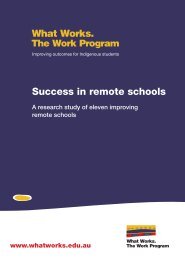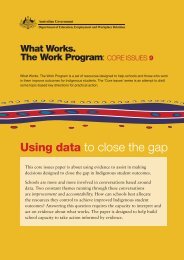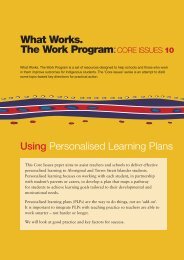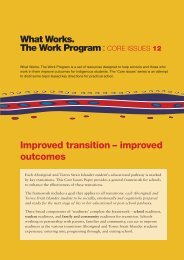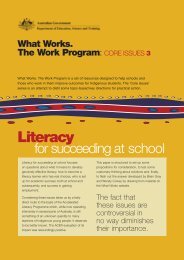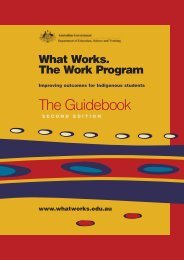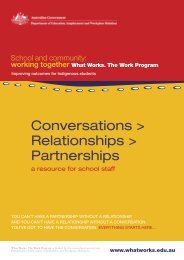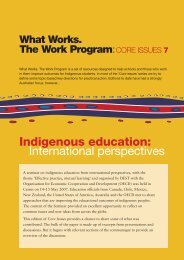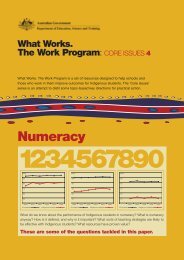Bound for Success Scope and Sequence Statements
Bound for Success Scope and Sequence Statements
Bound for Success Scope and Sequence Statements
- No tags were found...
Create successful ePaper yourself
Turn your PDF publications into a flip-book with our unique Google optimized e-Paper software.
HEALTH AND PHYSICAL EDUCATIONPersonal DevelopmentIn Year 1the student:In Year 2the student:In Year 3the student:In Year 4the student:In Year 5the student:In Year 6the student:In Year 7the student:In Year 8the student:In Year 9the student:In Year 10the student:• Describes emotionsincluding happy, excited,shy <strong>and</strong> frightened.• Discusses the importanceof managing emotions –that it’s OK to feel angry<strong>and</strong> tell someone but it’snot OK to react violentlyin anger. Plans <strong>for</strong> <strong>and</strong>applies alternativereactions to challengingsituations (e.g. take threedeep breaths be<strong>for</strong>e retryinga difficult task).• Identifies characteristicsthat make individualsdifferent from others <strong>and</strong>there<strong>for</strong>e ‘special’.• Demonstratescooperation in smallgroups in work <strong>and</strong> playincluding: taking turns,sharing equipment,communicatingeffectively, makingfriends.• Discusses changes thatare being experiencedincluding: growing taller,learning to read, makingnew friends, losing babyteeth.• Applies appropriateconventions, includingmanners <strong>and</strong> schoolprocedures, when relatingto teacher/s, other students<strong>and</strong> visitors.• Explores ‘self’ in thecontext of family,friendship group <strong>and</strong>school. Identifies personalqualities, interests,learning styles <strong>and</strong> othercharacteristics.• Role plays assertive voice<strong>and</strong> posture − brave talk(e.g. when a friend wantsto break a school rule orwhen reporting anincident, or advocating <strong>for</strong>a friend).• Identifies body cues –such as ‘butterflies’ – thatsignal changes in personalfeelings. Manages theseemotions in challengingsituations (e.g. speaking infront of the whole class<strong>and</strong> attempting a newskill).• Demonstrates ways toencourage <strong>and</strong> supportothers including listeningattentively to news,spending time playingwith friends, <strong>and</strong> invitingothers to join in a game.• Demonstrates skills <strong>for</strong>cooperation, safety <strong>and</strong>independence withequipment, <strong>and</strong>demonstrates acceptanceof situations where thereare winners <strong>and</strong> losers.• Describes personal needs<strong>and</strong> interests <strong>and</strong> howthey have changed frominfancy to the presenttime.• Explains qualities <strong>and</strong>characteristics that aresimilar to <strong>and</strong> differentfrom other people <strong>and</strong>how this contributes to asense of self. Describescharacteristics <strong>and</strong>qualities that make allpeople unique such as eyecolour, generosity,friendliness.• Labels a ‘high five’diagram − on each fingerof a h<strong>and</strong> nameappropriate friends <strong>and</strong>family to seek help fromwhen feeling lonely,unsafe or simply wantingcompany.• Discusses how roles <strong>and</strong>responsibilities changeas we grow older <strong>and</strong> thatmales <strong>and</strong> females mayhave different needs <strong>and</strong>interests.• Discusses physicaldifferences betweenmales <strong>and</strong> femalesincluding body shape <strong>and</strong>different sex organs.Discusses how a variationin growth rates amongpeers is normal.• Justifies actions infamiliar situations <strong>and</strong>differentiates between ‘Ihave to’ <strong>and</strong> ‘I want to’.Identifies what actions areof personal importance(e.g. says “ I like to paint<strong>and</strong> I like outdoorgames”).• Discusses how positiverelationships enhancefeelings <strong>for</strong> all who areinvolved in therelationship.Demonstrates cooperativeskills (e.g. I involve othersby pausing or altering anactivity <strong>and</strong> inviting themto join in).• Demonstrates personalresponsibility inclassroom <strong>and</strong> otheractivities (e.g. taking onspecific roles <strong>and</strong>following through oncommitments).• Switches between codesof behaviour to suitcircumstances, such assports field to classroom,home to school.• Explains how differentways of describing <strong>and</strong>relating to other peopleinfluences the way peoplevalue <strong>and</strong> treatthemselves <strong>and</strong> others.• Identifies the physicalchanges that occur aspeople age such as gettingtaller, stronger <strong>and</strong>knowing more, <strong>and</strong> howthese changes can beeffected by good health(e.g. a balanced diet <strong>and</strong>active lifestyle enhancesenergy, helps preventillness <strong>and</strong> contributes to aheightened sense ofwellbeing).• Explores <strong>and</strong> recognisesfeelings associated withbody changes duringgrowth.• Manages emotions usinga variety of strategies suchas counting to ten,prioritising tasks, takingpreventive action, selftalk,early recognition,changing things that canbe changed throughplanning <strong>and</strong> practice.• Devises <strong>and</strong> role playsstrategies to solveproblems <strong>and</strong> manageconflict while recognising<strong>and</strong> accepting differences<strong>and</strong> the rights, values <strong>and</strong>feelings of others.• Demonstrates actions,behaviours <strong>and</strong> attitudesthat support positiverelationships withdifferent groups of people,including people fromother cultures (e.g. how tobe.g.in conversation witha new student, ways toinclude others in socialactivities, learning aboutthe beliefs <strong>and</strong> traditionsof other cultural groups).• Describes a wider rangeof feelings <strong>and</strong> emotionsassociated with change<strong>and</strong> describes how peoplemanage them. Explainshow emotions can bere.g.ulated by managingcircumstances <strong>and</strong>deepening selfunderst<strong>and</strong>ing.Uses richervocabulary (synonyms) todescribe emotions (e.g.amused, delighted,thrilled or overjoyedinstead of happy).• Role plays ways tomanage being left out,ignored, put down, notselected, teased or losingincluding what to do, howto manage emotions, <strong>and</strong>where to get help.• Explores different roles<strong>and</strong> responsibilities inrelationships <strong>and</strong> takeson various roles withingroup activities with afocus on communicationskills <strong>and</strong> positive ways todeal with conflict.• Demonstrates assertiveverbal <strong>and</strong> non-verbalcommunication withfriends <strong>and</strong> family (e.g.explaining views about asensitive issue).• Describes the changesthat occur duringpuberty <strong>and</strong> how the rateof change varies amongindividuals.• Demonstrates ways toshow care <strong>and</strong> respectincluding assisting othersto communicate, offering<strong>and</strong> accepting help, <strong>and</strong>asking permission.• Role plays ways to join anew group <strong>and</strong> initiate<strong>and</strong> maintainconversation.• Actively contributes togroup cohesion <strong>and</strong>effectiveness by offeringopinions, listeningattentively, seekingclarification, acceptingresponsibility, followinginstructions.• Describes the physical,social <strong>and</strong> emotionalfactors that influencepersonal identity, <strong>and</strong>how one’s sense ofidentity may changeduring puberty.• Discusses how pubertalchanges may affectrelationships <strong>and</strong> selfesteem.• Demonstrates moreadvanced skills <strong>for</strong>establishing <strong>and</strong>maintaining positive <strong>and</strong>caring relationshipsincluding: empathy <strong>and</strong>respect in relationships,expressing feelings <strong>and</strong>points of viewappropriately, negotiating,effective communication,<strong>and</strong> practising assertivebehaviours. Demonstrateshow to deal with positive<strong>and</strong> negative commentsfrom peers.• Manages conflict throughstrategies <strong>and</strong> attributesincluding: re-evaluatingpersonal position, selfmonitoringvoice tone <strong>and</strong>volume, separating theperson from the issue,offering suggestions,accepting the umpire’sdecision, negotiating ingood faith, dealing withown <strong>and</strong> others’ anger,<strong>and</strong> respondingappropriately to teasing.• Describes the physical<strong>and</strong> emotional changesthat are part ofmaturation <strong>and</strong> strategiesto cope with the changes.Discusses specificchanges in thereproductive structures<strong>and</strong> functions that occurduring early adolescence(puberty).• Describes qualities <strong>and</strong>virtues that we value infriends such as honesty,loyalty, trust, sharing, <strong>and</strong>sincerity. Uses words <strong>and</strong>actions that convey thesequalities in a range ofcircumstances.• Challengesdiscrimination <strong>and</strong>harassment, activelyvaluing the differencesbetween individuals.• Identifies the influenceson personal sense of selfas individuals make thetransition to adolescenceincluding changing bodyimage, sexual maturation,<strong>and</strong> new skills <strong>and</strong>interests.• Demonstrates a growingawareness of uniquepersonal identity <strong>and</strong> theidentity of others. Thisincludes a growingawareness of the influenceof others <strong>and</strong> the impactof personal maturation onpersonal identity.• Identifies ways to buildpersonal capacity –physical, social <strong>and</strong>emotional (e.g. by tryingnew activities).• Demonstrates awareness<strong>and</strong> underst<strong>and</strong>ing of howrelationships can changeover time. Devisesstrategies <strong>for</strong> coping withchange, grief <strong>and</strong> loss(e.g. discuss going toboarding school <strong>and</strong> theresulting impact onrelationships).• Manages conflict throughstrategies includingassertive language,<strong>for</strong>ward planning,negotiation, <strong>and</strong> focus onthe issues.• Describes changingfamily <strong>and</strong> peerrelationships that occurin adolescence <strong>and</strong>discusses the positive <strong>and</strong>negative impacts of thepeer group duringadolescence.• Explores <strong>and</strong> discusseshow positiverelationships areenhanced byunderst<strong>and</strong>ing diversity<strong>and</strong> difference, <strong>and</strong>demonstrates personal <strong>and</strong>interpersonal skillsincluding assertiveness,questioning, <strong>and</strong> justifyinga position.• Identifies <strong>and</strong> analyses thelinks between thoughts,feelings <strong>and</strong> behaviour(e.g. feelings of anxietycan result in sweating <strong>and</strong>headaches). Discusseshow <strong>and</strong> why thoughts,• Identifies challenges <strong>and</strong>opportunitiesexperienced at this stageof their lives. Identifies<strong>and</strong> selects strategies toaddress these challengesincluding developinginterpersonalcommunication skills <strong>and</strong>establishing supportnetworks of both adults<strong>and</strong> peers.• Assertivelycommunicates decisionsabout personal health <strong>and</strong>physical activity withpeers, especially whenconfronted by unwantedpeer influence.• Analyses how individuals<strong>and</strong> groups may seek toinfluence the behaviourof others. Role playsharm-minimisationstrategies includingconflict resolution,negotiation <strong>and</strong> refusalskills − to deal with theseinfluences.• Demonstrates processes<strong>for</strong> managing change<strong>and</strong> conflict inrelationships includinghow to consider <strong>and</strong>accept other people’sperspectives.• Distinguishes betweenpositive use of power <strong>and</strong>abuse of power inrelationships. Discusses<strong>and</strong> role plays ways todevelop, maintain, or end,a relationship whenpower, gender, race orculture are (or become)issues.• Investigates <strong>and</strong> describesthe physical <strong>and</strong>emotional changes thatare part of maturation<strong>and</strong> devises strategies tocope with the changes.• Demonstrates increasingbreadth <strong>and</strong> depth inrelationship skills suchas:− helping behaviour <strong>and</strong>compassion (e.g.participating in acharitable activity),− knowing what toconsider when decidingif something is fair <strong>and</strong>just (e.g. think aboutthe other person’s• Describes personalstrengths <strong>and</strong> how to usethese to make changes inother areas of life.• Confidently <strong>and</strong>assertivelycommunicates a point ofview by making <strong>and</strong>defending decisions −both independently <strong>and</strong> aspart of a group - (e.g.when umpiring a game orjustifying a healthdecision).• Interprets <strong>and</strong> uses nonverbalcommunicationsto monitor the feelings ofothers <strong>and</strong> expresspersonal thoughts <strong>and</strong>feelings.• Demonstrates personalskills <strong>and</strong> strategies thatsupport the rights <strong>and</strong>feelings of others while<strong>for</strong>ming, adapting,developing <strong>and</strong> endingrelationships.• Describes how youngpeople can express theirpersonal identity <strong>and</strong>sexuality in ways that arerespectful of others <strong>and</strong>will not result in harm toself or others (e.g. making<strong>and</strong> breaking friendships,expressing closeness,appropriate touching, <strong>and</strong>respecting privacy).• Analyses own <strong>and</strong>others’ communicationskills, identifyingstrengths <strong>and</strong> areas <strong>for</strong>improvement. Setspersonal goals <strong>for</strong>enhancement of weakerskills. Maintains a journalto track progress.• Raises issues of concernto self <strong>and</strong> others (e.g.challenge injustice in anassertive, non-threateningway).• Demonstrates enhancedsense of self <strong>and</strong>community such as:− sensitivity <strong>and</strong>tolerance of self <strong>and</strong>others (e.g. respondpositively to criticism),− consideration <strong>for</strong> othersin group <strong>and</strong> teamactivities (e.g. share theworkload, play in anon-preferred position),• Identifies <strong>and</strong> discussessignificant transitions inan adolescent’s life, suchas be.g.inning a casual job<strong>and</strong> getting involved inmore seriousrelationships. Suggestsstrategies to deal withthese in ways that enhanceresilience <strong>and</strong> self-esteem.• Evaluates the influence ofdifferent beliefs <strong>and</strong>values - including thoserelated to sexuality <strong>and</strong>gender − on self-esteem<strong>and</strong> decision-making (e.g.explore the relationshipbetween body image <strong>and</strong>gender, <strong>and</strong> the impact ofthe media on the notion ofthe ideal male <strong>and</strong> femalebody types).• Assesses the level ofintensity in a range ofemotions <strong>and</strong> manages orexpresses theseappropriately in differentcontexts. Transfersemotional managementstrategies betweencontexts (e.g. angermanagement strategieslearned in sport can betransferred to the homesituation).• Demonstrates (e.g.through role play)flexibility <strong>and</strong> maturityin underst<strong>and</strong>ing <strong>and</strong>managing emotions (e.g.uses self-talk to monitor<strong>and</strong> manage emotions,asks open-ended questionsto determine otherpeoples’ perspectives,uses consistent st<strong>and</strong>ards<strong>and</strong> limits as referencepoints <strong>for</strong> decisions aboutbehaviour).• Demonstrates maturedecision-making thatincludes:− underst<strong>and</strong>ing thesituation <strong>and</strong> context,− people, risks, is adecision required?− planning to make adecision - analysepersonal strengths,attitudes,responsibilities <strong>and</strong>goals,− deciding <strong>and</strong> acting -choosing from options,communicating adecision, acting on thedecision,<strong>Bound</strong> <strong>for</strong> <strong>Success</strong> <strong>Scope</strong> <strong>and</strong> <strong>Sequence</strong> <strong>Statements</strong> V2 Page 22 Working Document Semester One 2007



